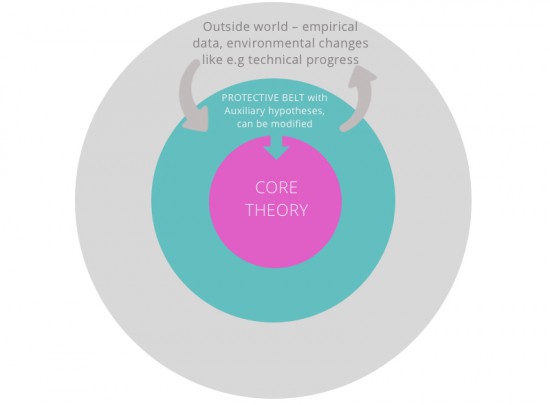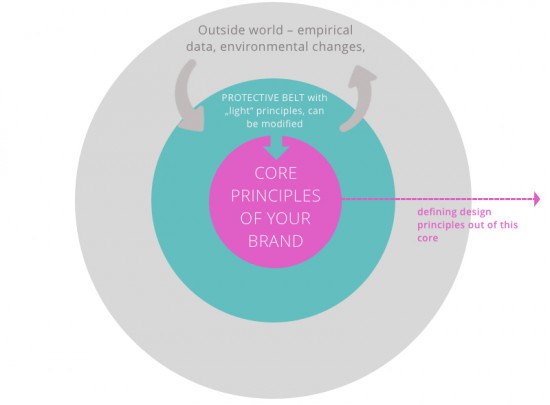
How a set of „core principles“ will help you in accomplishing a shared design culture and understanding in your company.
In science theory there is an approach called „Methodology Of Scientific Research Programs“ which was introduced by Imre Lakatos who was a student of famous Karl Popper.
In general and simply explained, science theory helps us to understand in how science could make progress and wants to explain how we build our knowledge about the world and it’s therefore strongly connected to epistemology and these two ground philosophical questions:
„What is knowledge?“ and „How could we know what’s the truth?“
The „Scientific Research Programs“ approach was – like mentioned – developed by Poppers student Imre Lakatos out of Poppers „falsificationism“ science theory: Poppers first falsificationism approaches were to abandon any theory as soon as there is an evidence which appears to challenge the given theory.
Imre Lakatos changed this, because there were some real problems with Poppers standards. Falsificationism basically means somehow trial and error. Falsificationism is all about that you cannot prove that a theory is „right“ but you can prove it may be „wrong“. This is based on philosophical and logical problems.
One risk with this approach is, that you will throw away valueable and often groundbreaking theories by mistake way too fast. Thats not justifiable speaking in terms of scientific progress. Who knows what would have happened if Kopernikus theories were rejected because there were so many quality and empirical arguments _against_ it at this time.
One of the problem with the first falsificationism approaches was time and the problem of discarding a theory too fast as „wrong“ by mistake.
More time was needed to develop a good and reliable theory. Scientists need a chance to work on it in full concentration with only this theory and no other theories in mind. Lakatos‘ approach therefore was that scientists should work on a theory within a structured conceptual model – which can be seen as the research program. It was all about to give those research programs time and opportunity to develop and prove the capability of the theory!
What does this conceptual model look like?
1) The main point of the model is that the model has a „hard core“ wherein the basic assumptions of the theory are written down and this core has to be defended against falsification, which means no one may change it that easily: Hypotheses that aren’t meant to be changed no matter what .. (except… well.. we’ll come to this point in a minute)
2) On the outside there’s a „protective belt“ which contains so called auxiliary hypotheses that may be modified under certain circumstances. The belt complements the inner hard core, which should not be touched. But there’s also an interplay between the „real world outside“ and the „protective belt“ with its auxiliary hypotheses: The auxiliary hypotheses that may be modified interact with the empirical world on the one hand and on the other hand with the untouchable core. If there are changes in the empirical world like e.g.technological progress, some of the auxiliary hypotheses can be modified according to the changed environmental conditions. The more auxiliary hypotheses may „fail“ the weaker becomes the core.

This kind of conceptual structure creates a „system“ to work within and reduces the complexity of falsification (e.g. by mistake) plus gives opportunity to pursue the theory.
This is the very basic explanation of how a scientific research program does work.
What has Lakatos‘ philosophy to do with a design driven company culture?
You can transfer parts of this conceptual structure model easily to branding and design principles.
Look at the untouchable „core“ like this: The guidelines you’ll define for your brand is like a basic „theory“. You put them inside the „core“. Once defined, they cannot be touched. They are protected though a belt of „lighter“ brand principles/definitions which may change due incoming data like the change of social or cultural trends etc.
If the auxiliray hypotheses – aka the lighter principles which are open for modification – will be more and more modified throughout time you’ll reach a point where you may rethink your core theory aka brand definition. But that’s a slow process.
It is important to begin at this core to define your brand principles. They represent your „core theory“. Everything else, even the „protective belt“ with its „lighter principles“ is built on it.
Everybody in the team should have a shared understanding of this „core principles“. So, everybody is working in one direction. The advantage of this approach is clear: You build a set of shared values and a shared understanding of what your brand represents and how your brand should feel like and therefore how the brand should communicate with the outside world. Those core principles will define the design principles you will use when it comes to communication with the outside world.

How can you define that core?
First, ask yourself how would you like your brand to be perceived?
There’s a method I really like because it is that easy: Use an adjective list to describe the brand. Yes, the same way you do when it comes to describing people – think of your brand as a human being: How will she/he be like? How will she/he behave in different situations? This could be everything like „young“ „funny“ serious“ „grown up“ etc.
Once you have a set of adjectives you have described how you’d like to be perceived. This is your very basic „set“ of the brand. I call this core principles, which are a good starter set. That sounds easy, well? Everybody wants to be likeable and friendly :)
The hard part is to make this core set „untouchable“. It requires decisions. Basically the decision, to stick to it, no matter what. It requires in addition that you believe in what you have written down.
Draining off design principles from the core and create a shared understanding
Once you’ve mastered the hard part you are able to drain off single design principles out of this basic core. For example like „tone of voice“ in your communication materials or „interaction behaviour“ (yes it’s communication too) at your digital windows to the world like websites, apps or whatever.
If you had definied that you are „funny“ there will be another tone of voice as if you had defined „serious“ in your basic core set. Or, for example an error message could be (look and behave) totally different based on which core priniciple it is based on. It creates consistency on a high level.
The next step is, to communicate those core principles within your company. Make posters, hold design meetings with all department heads. Do whatever is necessary to communicate clearly what this core principles are about, and why they exist. Be transparent to your team.
The „core“ which is protected, will help you to stick to your principles. It will make design decisions much more easier and ensure a consistent image to the outside world throughout every medium.
In addition, it definitely will help you in creating a shared understanding of the brand and importance of design and therefore in creating a „design driven“ culture in your company everybody will stick to.
Image source: heliocentrism, wikipedia
https://en.wikipedia.org/wiki/Heliocentrism